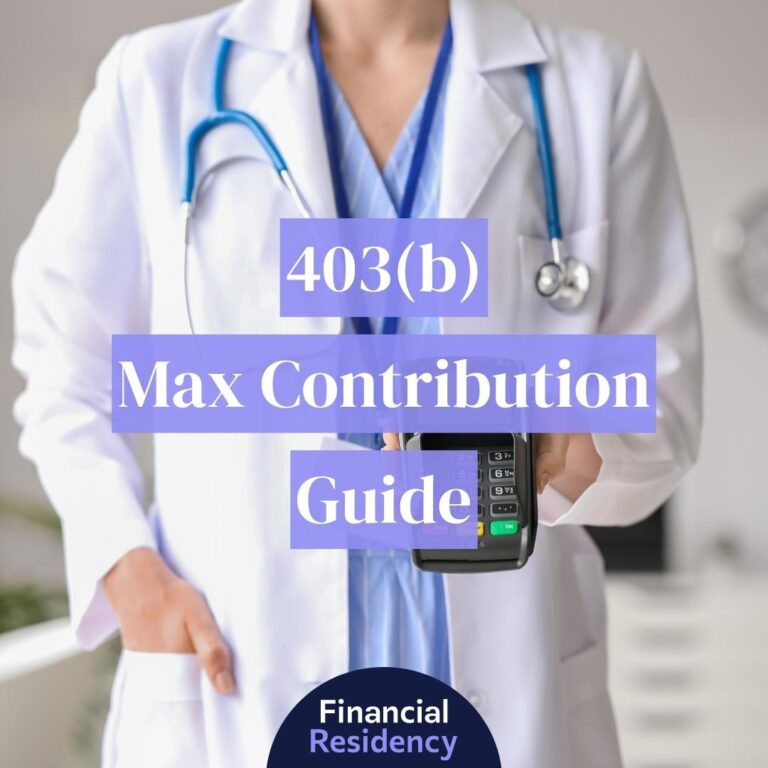Unfortunately, there isn’t a class on the best ways to invest $1000 dollars in medical school. Knowing how to navigate your personal finances is an important life skill, but it’s far from common knowledge.
Physicians and other high-income professionals are in a great position to start thinking about financial planning because their earning potential is likely to increase as they progress through their careers.
If you’re paying all your bills on time and saving for the future, you might be wondering how you can make your money do more for you in the long run.
You can take a do-it-yourself investment strategy or you can consult with a financial advisor to find the best assets for your needs.
In this article, we’ll recommend the best ways to invest $1000 dollars so you can learn the ropes of the market and find the investments that work best for your financial goals.
11 Best Ways to Invest $1,000 Dollars Wisely
There are a few things you can do to invest $1000 dollars wisely today:
- Pay Off Existing Debt
- Establish an Emergency Fund
- Open an IRA
- Open a High-Yield Savings Account
- Take Advantage of Employer-Match 401(k) Contributions
- Contribute to a 529 Account
- Buy Fractional Shares of Stocks
- Work with a Robo-Advisor
- Purchase Stocks
- Acquire Real Estate
- Diversify Your Income
1. Pay off Existing Debt
Though paying off your debt doesn’t allow that money to grow, it does support increasing your net worth. Paying off your debt puts future money back in your pocket, which you can then use to invest in other options.
Whether you have medical student loans or credit card debt, paying it down can have a positive impact on your overall financial health.
We recommend the avalanche method, where you pay off your high-interest debt first. With the avalanche method, you make the minimum payment for all your debt obligations, but then you’ll allocate all extra discretionary funds to paying off the highest-interest debt.
Once that debt is paid off, you use the same strategy to pay off your debt with the next highest interest rate.
2. Establish an Emergency Fund
The best financial planning takes a holistic approach, which means you have to be thoughtful about short-term and long-term goals. Being thoughtful also means planning for the unexpected.
Most investments have time horizons in the short term and the long term, but even the shortest time horizons don’t offer penalty-free withdrawal in the event of an emergency.
Building an emergency fund is an investment in oneself. If you have an injury, job loss, family tragedy, or any other number of unexpected life events, an emergency fund can give you the financial freedom to focus on yourself without letting your living expenses fall to the wayside.
A strong emergency safety net should have enough funds to cover 6–12 months of essential living expenses, such as housing, car payments, groceries, and child care, but your first $1,000 is a great place to start.
3. Open an IRA
An individual retirement account (IRA) is a tax-advantaged retirement planning tool.
While it’s not as exciting or salacious as investing in the stock market, retirement planning can have returns on multiple fronts. Not only can it provide large returns on investment, but contributions can have major tax advantages.
Opening an IRA is a commitment to investing in your retirement and you can also deduct your contributions on your taxes, so it has layers of financial benefits.
If you invest in a pre-tax IRA, you can deduct the $1,000 from your regular income tax, but you’ll be liable for those taxes when you withdraw that money later.
Pre-tax IRAs allow you to contribute up to $6,500 annually if you’re under 50. If you’re over 50 years old, you can contribute up to $7,500 and deduct those contributions from your income tax.
If you invest in an after-tax IRA, such as Roth IRA, you’ll be able to withdraw all the money without taxes when you reach retirement age.
Roth IRAs can be particularly advantageous for physicians who expect to be at their highest earning potential later in their careers because they won’t lose any of their investment gains to taxes upon withdrawal.
Learn More:
4. Open a High-Yield Savings Account
If you’re not yet comfortable taking a risk on market-based assets, opening a high-yield savings account, such as a Certificate of Deposit (CD) can help you grow your money with a higher APY than a traditional savings or checking account.
You can place your emergency fund in a money market account, CD, or other high-yield savings account depending on your savings objectives. These accounts are also a great place to keep your vacation fund or money put away for a down payment.
CDs allow you to earn interest on a lump sum amount, but they typically have a time requirement you have to meet before you can make a withdrawal.
Money market accounts and other high-yield savings accounts allow you to withdraw your money at any time, but there may be limits on the number of withdrawals you can make in a given period.
CDs, money market accounts, and high-yield savings accounts offer compound interest at a higher interest rate than traditional savings and checking accounts, which allows your money to do more for you in the long run.
High-yield savings accounts are an excellent way to invest without taking on too much risk while still allowing your money to grow.
5. Take Advantage of Employer-Match 401(k) Contributions
If your employer matches 401(k) contributions, you should consider maxing that out. Matched contributions are free money and it’s important to take advantage of this benefit if it’s provided with your employment.
Like IRAs, 401(k)s allow you to invest your pre-tax dollars to reduce your income tax liability. Employer-match 401(k) contributions can be an excellent vehicle for early-career medical professionals, residents, and new physicians to begin saving for retirement while taking advantage of tax credits.
Retirement contributions to your 401(k) can qualify you for a tax credit between 10 and 20% of the contribution amount.
6. Contribute to a 529 Account
529 education funds can be used for your or your loved one’s future education expenses, including tuition, textbooks, and other learning materials. These funds can be withdrawn from the account tax-free, which makes it a worthwhile investment for anyone who values education. 529 funds can be considered an investment because the money grows tax-free.
Any leftover funds can later be rolled into a traditional IRA without penalty, so you can plan for the possibility of paying for education expenses without fear of the money going to waste if life changes course.
529 funds are not tax deductible at the federal level, but you can receive some benefits on your state tax returns.
You or anyone can later withdraw these funds for qualified educational expenses without any tax obligations.
7. Buy Fractional Shares of Stocks
Jumping into the market feet first can be daunting, but buying fractional shares can allow you to grow your understanding by only risking a small amount of money. Fractional shares are portions of the total stock, so you don’t even have to have enough money to purchase the full share.
If you’re willing to research the front end, buying partial shares of 5 stocks can be a great way to get your foot in the door by investing in your favorite companies. Buying fractional shares can carry more risk than funds because they’re more volatile.
Buying fractional shares of individual stocks is another way to start trading stocks without putting all your eggs in one basket.
You can buy fractional shares by opening a brokerage or investment account. Robo-advisors, such as Acorns, Betterment, Stash, and human stock brokers can help you decide which fractional shares to purchase.
8. Work with a Robo-Advisor
If you prefer a hands-off approach or you’re not yet confident enough to invest on your own, a robo-advisor can build an investment portfolio around your risk tolerance, desired rate of return, and investment goals.
While investment advice used to be an expensive asset, the growth of the financial technology sector and its applications afford the general public access to low-cost investment opportunities with competitively low fees.
Robo-advisors are excellent at providing easy-to-digest educational resources, compelling charts for expected growth, and tools to help inform your investment decisions.
9. Purchase Stocks
Index funds are a beginner-friendly vehicle for investing in stocks.
The S&P 500 is a list of the 500 most successful companies in America. The S&P 500 index fund is a collection of stocks from all the companies that make up that list.
It’s often recommended to new investors because it offers guaranteed diversification, which means all your money isn’t tied up in one stock option.
There are other index fund options, such as the Nasdaq 100, that track other publicly traded companies in the market.
Mutual funds and exchange-traded funds (ETFs) are other vehicles to dabble in purchasing diverse stock options.
Mutual funds, like index funds, have a collection of stock options giving them its value, but unlike index funds, mutual funds don’t follow a set list of securities. The manager of mutual funds makes the decisions on which securities to buy and sell.
Both index funds and mutual funds are good options for investors who want a more hands-off investment strategy.
ETFs are similar to mutual funds in that they are a collection of securities, but unlike mutual funds, they can be traded just like stocks while the market is open.
10. Acquire Real Estate
While $1,000 isn’t likely to get you far with a down payment for a conventional mortgage, physicians have access to zero down payment options through physician loan programs. However, it’s not the only way to start earning money through real estate investments.
Real Estate Investment Groups (REIGs) and Real Estate Investment Trusts (REITs) allow you to get involved in the rental market without the financial exposure and time commitment of managing properties on your own. Both REIGs and REITs are crowdfunding vehicles that purchase real estate on behalf of investors.
REIGs are similar to mutual funds, but instead of a pool of investors owning shares of a company, they own shares of a rental property. Investors can buy units in a building an REIG owns and earn income on leases. REIGs typically handle all the advertising, maintenance, and all the tedious aspects of property management.
REITs are similar to REIGs, but they afford more access to commercial properties, which can earn more in the long run, and are traded on the stock market as exchange-traded funds. They pay regular dividends and are considered a highly liquid investment because they are easy to sell.
Learn More:
- How to Invest in Real Estate
- How to Become a Real Estate Professional
- Physician Loans for Investment Properties
- Tax Benefits of Real Estate Investing
11. Diversify your Income
You can use $1,000 to invest in yourself by setting up a side hustle. These funds can be used to purchase equipment, set up an LLC, or begin marketing your side business. A thousand dollars goes a long way in terms of getting business cards and starting basic paid advertising on social media.
Some side business ideas include:
- Ridesharing
- Food delivery
- Car detailing
- House cleaning
- Pet sitting
- Nannying
- Catering
- Baking
Diversifying your income will allow you to invest more comfortably in your retirement or save for your future without sacrificing your current standard of living.
While a side hustle isn’t passive income in the way many of these other investments are, it can supplement your income and support your long-term savings goals.
Tips for Investing $1,000 Wisely
Unfortunately, investing isn’t taught in medical school, so it’s often something you have to learn on your own as you embark on your personal finance journey.
With that said, there are a few general tips you can consider as you dip your toes into investing $1000 dollars:
- Determine your investment goals: You’ll need the motivation to maintain your focus on investing because it doesn’t have an immediate payout. Part of finding this motivation is getting in touch with your desired time horizon for a return on investment. Short-term goals are less than five years away and long-term goals are more than five years away.
- Zero in on your investment strategy: You’ll want to be thoughtful about how much help you’ll want as you begin investing. Some people prefer to have an active role in the investing process because they have an inherent interest in it, but other people prefer to take a more passive approach by handing the reins to a portfolio manager. More passive investment strategies may incur additional management fees.
- Pick your investment account: Investments don’t exist in a vacuum and the funds have to be held somewhere. Different account options have different tax liabilities. Generally, beginners will look at 401(k)s or IRAs if the primary goal is saving for retirement. Other goals may do well in a brokerage account, also known as a taxable account, or a college savings account.
- Choose a combination of investments: You’ll want to invest in a variety of assets that meet your risk tolerance. You may want to purchase individual stocks, bonds, mutual funds, or real estate assets.
Understanding the Different Types of Investments
Investing can be broken down into three different categories: equity/securities, fixed-income, and cash/cash-equivalent.
Individual stocks, preferred shares, mutual funds, and ETFs are considered equity investments or securities because they allow you to own a portion of the company, but it is not liquid unless you sell your shares.
Bonds are a vehicle that loans money to a company. When the bond matures, the investor is paid back the loan plus interest or dividends.
Cash and cash equivalents are assets that you can easily access and withdraw money. Your checking, savings, CD, and money market accounts are considered cash equivalents.
Breaking Down the Fees
Different types of investments have different associated fees. We’ve broken down a few of the common investing fees you’re likely to encounter.
- Brokerage fees: Charged by an investing app or portfolio manager in exchange for advice, exclusive trading platforms, and proprietary data
- Trade commission: Charged when you buy or sell stocks, options, and ETFs
- Mutual fund transaction fee: Charged when you buy or sell mutual funds
- Expense ratio: Charged as a percentage of your total investment in a mutual fund; typically charged annually
- Sales load: A commission given to the broker of a mutual fund after a sale
- Advisory or management fee: Charged as a percentage of the assets managed; paid to a financial advisor, robo-advisor, or investing app
Investors can save on management fees by taking a DIY approach, but some investments will still incur trade fees. You can shop around for brokers that offer commission-free trades, such as Charles Schwab, Fidelity, TD Ameritrade, and Robinhood.
Frequently Asked Questions
Are investing apps safe?
Investing apps protect funds the same way any brokerage firm does, but there are a few things you can do to ensure an app is above-board. You’ll want to find an investing app that’s a member of the Securities Investor Protection Corporation (SIPC).
The SIPC helps investors recover up to $500,000 if the investing app goes out of business, but it does not protect against losses due to the market. It also doesn’t protect cryptocurrency investments. All registered brokers are required to be a member of the SIPC.
In addition to the SIPC, you’ll want to make sure the investing app is registered with the U.S. Securities and Exchange Commission (SEC) and the Financial Industry Regulatory Authority (FINRA).
The SEC and FINRA maintain directories where you can look up the apps you’re most interested in.
What investments are tax-free?
Some investments may have tax advantages, but it’s not always cut and dry. The following investments may pay tax-free interest or dividends:
- Bonds
- Mutual funds
- Money market funds
- Trusts
- Life insurance
- Roth IRA
- 529 plan
- Health savings account
- Fixed annuities
You can consult a tax professional, such as a tax attorney, to better understand the tax-advantaged accounts available to you.
Are investment fees tax deductible?
Yes, investment fees can be tax deductible if your investment interest expenses are less than your net investment income.
To deduct investment expenses, you’ll have to file a Schedule A form and itemize your deductions.
However, it’s important to note that the Tax Cuts and Jobs Act of 2017 eliminated miscellaneous itemized deductions, which previously allowed taxpayers to deduct fees for investing advice, IRA custodial fees, and accounting costs.
What investments are best for beginners?
There are a number of ways beginners can start investing. Some of the most beginner-friendly investments include the following:
- High-yield savings account
- CDs
- Workplace retirement plan
- Mutual funds
- ETFs
- Individual stocks
A financial advisor with a fiduciary responsibility can advise you on the best investment options for your short and long-term financial goals. As a general rule, it’s always a good idea to focus on building a diversified portfolio to spread out your risk exposure.
How Should You Invest $1000 Dollars?
The best ways to invest $1,000 will ultimately come down to your desired time horizon and financial goals, but research is a great place to start building long-term wealth.
In general, we recommend working your way down this list and making sure you are buttoned up with your current debt obligations, emergency fund, and retirement planning. After achieving your goals in those areas, you can begin investing in more volatile assets and you may even see a greater possibility of return.
The most important thing you can take away from the investing world is to make sure you have a diversified portfolio. In other words, make sure your money is in a variety of assets so you aren’t over-leveraged in any one area.
You’ll want a mix of cash assets you can easily withdraw in an emergency as well as short-term and long-term investments.
A financial planner or an attorney with a fiduciary responsibility can help you make the most of the funds available to you. With the right investments, you can be on your way to financial freedom.




